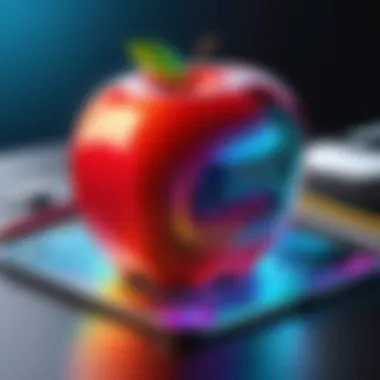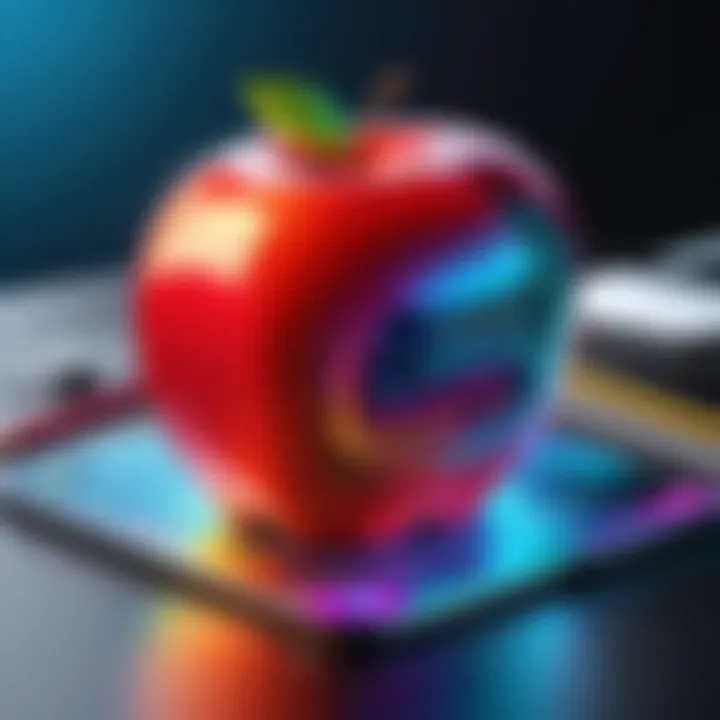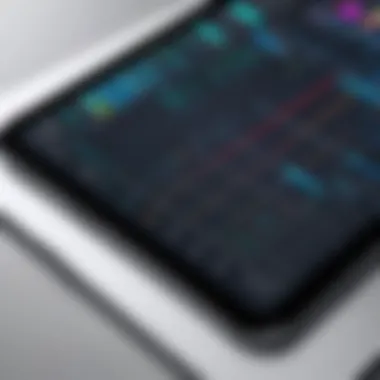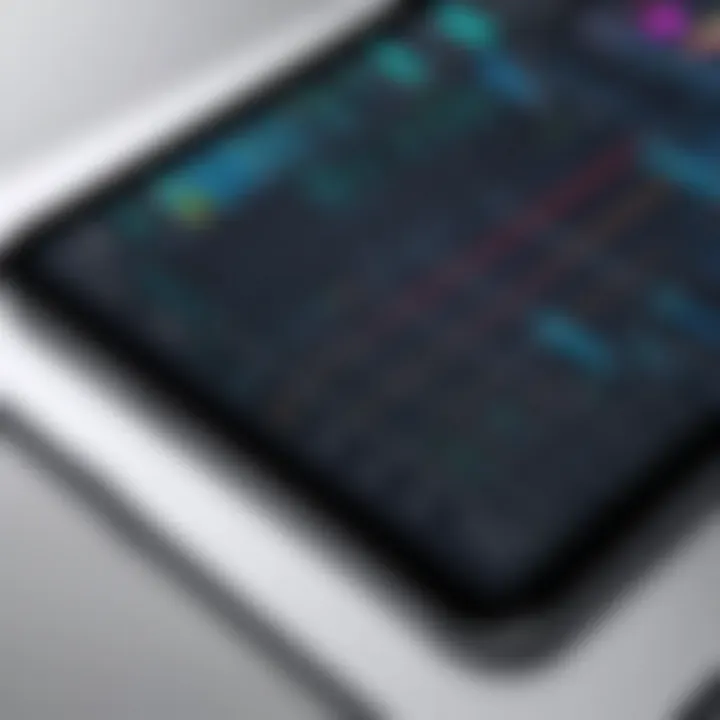Exploring Top Drawing Apps for Apple Devices


Intro
In today’s increasingly digital landscape, drawing applications on Apple devices have become essential tools for artists, designers, and hobbyists alike. The seamless integration of hardware and software offers a unique environment for creativity, enabling users to produce art that rivals traditional mediums. This examination will delve into various drawing apps available on Apple devices, analyzing their skills and identifying their uniqueness, to help you make informed choices.
As Apple continues to innovate, its devices, such as the iPad and iPhone, have introduced new capabilities, paving the way for sophisticated drawing tools. Thus, understanding the range of applications available becomes crucial, whether one is a professional artist seeking advanced features or an enthusiast exploring their creativity. We will explore the key features, product specifications, and performance of popular applications, providing insights that are beneficial for both casual users and professionals.
Key Features
The richness of drawing applications largely depends on their features, which can significantly impact the user experience. Here are some critical components:
Design and Build Quality
When assessing a drawing application, the design and user interface are vital. Applications should not only be visually pleasing but also intuitive and easy to navigate. For instance, Procreate offers a clean layout with customizable shortcuts, making it simple for users to access their preferred tools quickly. On the other hand, Adobe Fresco projects a familiar interface for users who have experience with other Adobe products.
Additionally, the build quality of the app matters. Apps that often update their functionalities, such as Affinity Designer, enable users to utilize the latest features, enhancing overall performance.
Display and Performance
Display compatibility is another significant aspect to consider. Drawing apps leverage the Apple Pencil's capabilities exceptionally well, providing smooth pressure sensitivity and responsiveness. Programs like Concepts utilize these features effectively, making linework fluid and precise.
Performance under various conditions is an essential factor. Apps should function seamlessly across different Apple devices, such as iPads and MacBooks, and adapt well to multitasking environments. A combination of robust features and consistent performance allows artists to maintain focus on their creative tasks without interruptions.
"The right drawing app not only enhances your creative outputs but also enriches the overall experience of digital artistry."
Product Specifications
Understanding the specifications of drawing applications can help users select the best fit for their needs.
Technical Specifications
Every drawing application offers specific technical traits. Some key specifications to look for include:
- Resolution: Higher resolutions allow for more detailed artwork.
- Brush Settings: Diverse brush options cater to various artistic styles.
- Layer Management: Efficient layer handling promotes complex compositions.
For instance, Corel Painter allows for a high degree of customization regarding brushes and textures, making it a favorite among illustrators.
Compatibility and Connectivity
Compatibility with other software can greatly benefit users. Applications that integrate with Adobe Creative Suite, for example, allow easy asset transfers. Moreover, consideration should be given to apps requiring specific versions of iOS or macOS for optimal functionality.
Additionally, cloud-based storage can help users save and access their work across devices, making applications like SketchBook more appealing due to their connectivity options.
Preface to Drawing Apps on Apple Devices
In the modern age of digital creativity, drawing applications have emerged as essential tools for artists and casual creators alike. These apps cater to diverse user requirements and offer unique features that enhance the artistic process. Understanding the landscape of drawing apps on Apple devices is pivotal, not just for professionals, but for anyone who aspires to explore their creative potential.
The rise of digital art corresponds with new generations of artists, who often prefer using technology to traditional mediums. Drawing apps provide the convenience of portability, flexibility, and a diverse array of tools. They allow users to create stunning visuals without the constraints of physical materials. This adaptability enhances the overall art-making process, making it engaging and accessible. Furthermore, many of these applications leverage the advanced capabilities of Apple’s hardware, resulting in a seamless user experience.
The Importance of Digital Art
Digital art is significant for several reasons. First, it democratizes artistic expression. Anyone with access to a device can explore their artistic abilities, irrespective of their background or experience level. Additionally, digital art allows for easier sharing and collaboration, as work can be distributed quickly through social media or online platforms.
Another critical aspect is the infinite possibilities it offers in terms of tools and techniques. Artists can experiment with various styles that may not be feasible in traditional mediums. Programs such as Procreate and Adobe Fresco feature brush customization and layer manipulation, enabling creators to push the boundaries of their artistic visions.
Overview of Apple’s Ecosystem for Creatives
Apple’s ecosystem serves as a fertile ground for creatives, thanks to its powerful hardware and software synergy. The iPad, in particular, has positioned itself as a preferred device for digital art, largely due to the Apple Pencil’s precision and responsiveness. This stylus creates an authentic drawing experience, closely mimicking traditional pen and paper techniques.
Moreover, Apple’s user-friendly interface fosters a smooth navigation experience, which is crucial for artist productivity. The App Store is replete with drawing apps that cater to various styles, from illustration to graphic design. Notably, the ability to integrate these applications with other tools within the Apple ecosystem enhances workflow efficiency. Artists can easily transfer their work between devices, ensuring they have access to their projects at any time or place.
"The integration of advanced technology in Apple devices has redefined how art is created, making it more accessible and versatile than ever before."
By examining the importance of drawing applications on Apple devices and understanding the ecosystem that supports them, users can better appreciate the role these tools play in modern artistry.
Exploring Popular Drawing Applications


Exploring popular drawing applications is crucial in understanding how digital artistry is evolving within the Apple ecosystem. These applications not only enhance creativity but also streamline workflows for artists and hobbyists alike. The suitability of an app can vary based on individual needs, such as professional requirements or casual use. Thus, analyzing the key players in the market will provide insight into their functionalities, benefits, and unique features. This section aims to present a deeper look into the most noteworthy drawing apps available.
Procreate: A Market Leader
Procreate stands out significantly among drawing applications, especially for iPad users. Its user interface is intuitive, catering to both beginners and advanced artists. Users appreciate the vast library of brushes and tools, which helps in enhancing their creativity.
Some key features include:
- Customization: Procreate allows extensive brush customization, enabling artists to create their unique styles.
- Real-Time Performance: It is known for its robust performance, minimizing lag even during complex illustrations.
- Layering System: The innovative layering system offers flexibility in editing, akin to professional software used on desktops.
Procreate has effectively transformed how artists interact with their work, making it a go-to choice in the digital art community.
Adobe Fresco: A Versatile Option
Adobe Fresco is another prominent name that integrates well into the Adobe ecosystem, making it a strong contender. It combines raster and vector tools, giving users the best of both worlds.
This app is particularly favored for:
- Live Brushes: These innovative brushes mimic traditional paint, providing an organic feeling in a digital environment.
- Integration with Adobe Suite: Seamless integration with Adobe Photoshop and Illustrator allows for a more comprehensive design process.
- Multi-Device Accessibility: Fresco functions across devices, ensuring artists can create wherever they find themselves.
Adobe Fresco has established itself as an essential tool for artists who wish to leverage the full capability of Adobe products while enjoying a fluid drawing experience.
Affinity Designer: Professional Tools
Affinity Designer attracted a professional audience due to its impressive set of features tailored for graphic design and illustrations. Its straightforward organization and tools provide a solid foundation for advanced creations.
Notable aspects of Affinity Designer include:
- Dual Environment: Users can switch between vector and raster workspaces seamlessly, making it versatile for various projects.
- Precision Tools: The app offers precision tools like guides, grids, and snapping, aiding in meticulous designs.
- One-Time Purchase: Unlike subscription-based software, Affinity Designer offers a one-time purchase model, appealing to budget-conscious professionals.
This application has garnered a loyal following among illustrators and graphic designers looking for professional-grade tools that deliver without ongoing fees.
Clip Studio Paint: Tailored for Illustrators
Clip Studio Paint has carved out a niche for itself, particularly among comic and manga artists. Its specialized tools for fine line work and detailed illustrations set it apart from general drawing applications.
Key features include:
- Inking Tools: The inking capabilities are optimized for precise line art, making it ideal for comic creation.
- Frame Management: Artists can easily manage and navigate multiple frames, which is essential for sequential art.
- 3D Models Integration: The inclusion of 3D models aids in illustrating complex perspectives and poses.
Clip Studio Paint remains a favorite among artists focusing on comics and manga, offering tailored features that simplify the creation process in these genres.
Technical Specifications of Drawing Apps
Understanding the technical specifications of drawing applications is crucial for any artist or designer using Apple devices. This section delineates how these specifications influence user experience, workflow efficiency, and overall output quality. Emphasis should be placed on specific elements that cater to different artistic needs and preferences.
Interface Design and Usability
A crucial aspect of any drawing application is its interface design and usability. A streamlined interface aids in reducing the learning curve for users. The organization of tools and features impacts how quickly an artist can access what they need. For instance, applications like Procreate and Adobe Fresco offer intuitive layouts.
Users can easily navigate through brushes, layers, and editing options without feeling overwhelmed. Hence, usability plays a significant role when professionals choose an app for their projects.
Moreover, touchscreen compatibility and gesture controls enhance the drawing experience on Apple devices. They allow for smooth transitions and precision in artwork creation. In this way, accessibility and responsiveness are integral for efficient workflow.
Brush Customization Features
Brush customization is another vital attribute of drawing applications. Different artists have varying styles; thus, they require tools that adapt to their methods. Advanced applications provide a wide range of brush types and settings. For example, Procreate allows users to create or modify brushes, adjusting parameters such as size, opacity, and texture.
This flexibility lets artists fine-tune their tools, achieving personal styles without limitations. Customization fosters creativity by enabling unique artistic expressions. Users must consider how each app manages this feature as it directly affects their final artworks.
File Compatibility and Export Options
File compatibility and export options are essential for professionals as they frequently collaborate across various platforms. An ideal drawing app should support multiple file formats, allowing artists to seamlessly integrate their work with other software.
Options such as PSD (Photoshop Document), PNG, and JPEG are commonly sought after. Furthermore, the ability to export in high resolution enhances the quality of prints and presentations.
Taking into account how easily users can backup and share their creations can drastically influence their choice of tool. It's necessary to investigate how different applications handle these aspects, which impacts overall productivity and convenience.


"The proper technical specifications in drawing apps can elevate a user’s experience, allowing for both innovation and efficiency in digital artistry."
Performance Comparison Among Top Apps
When considering drawing applications for Apple devices, performance is a critical factor that cannot be overlooked. Users seek applications that not only function seamlessly but also enhance their creative outputs. This section delves into vital performance metrics such as speed, stability, and device optimization, providing insight into how these aspects affect user experience.
Speed and Responsiveness
Speed and responsiveness directly influence the way artists express their creativity. A laggy application can disrupt the flow of the creative process, making it challenging to achieve precise strokes. Users rely on immediate feedback when drawing, especially when using features like brushes, layers, and effects. Applications like Procreate are known for their exceptional performance, enabling smooth, responsive interactions.
In contrast, applications that struggle with speed may frustrate users, leading to unsatisfying experiences. Endurance tests often reveal which apps can handle complex tasks without slowing down. In addition, the device's capabilities, such as RAM and processor speed, play a significant role in application performance.
Key Points on Speed:
- Immediate feedback is crucial for creativity.
- Lag affects drawing precision and flow.
- Procreate generally leads in speed tests.
Stability and Reliability
Stability is another essential element for users of drawing apps. An application's ability to run consistently without crashes affects productivity. Artists often spend hours on intricate work, and the last thing they need is an unexpected shutdown. For example, applications like Adobe Fresco have built a reputation for reliability, protecting users from data loss during unsaved sessions.
In terms of reliability, quality updates and bug fixes enhance software longevity. Regular updates can prevent issues that may hinder performance. Users should choose apps that provide strong support and have a history of stability.
Considerations for Stability:
- Crashes can lead to loss of work.
- Reliable apps foster user trust.
- Regular updates are necessary for smooth operation.
Device Optimization for iPad vs. iPhone
Each Apple device offers unique functionalities that can affect performance. iPads typically have larger screens and more processing power than iPhones, making them more suitable for detailed artwork. Applications were often optimized differently for these devices. For instance, Procreate performs exceptionally well on the iPad, taking full advantage of its capabilities like the Apple Pencil, while its performance on iPhone may not be as robust.
Choosing the best app for drawing means understanding how these optimizations impact workflows. iPad versions of drawing apps often include additional features not present on the iPhone, such as advanced brushes and layouts suited for larger canvases.
Key Differences in Device Optimization:
- iPads offer larger canvases and better hardware.
- iPhone versions may be more limited in features.
- Application performance can vary significantly between devices.
"Selecting the right drawing app depends heavily on the performance metrics. Speed, stability, and device optimization shape the overall user experience and productivity."
User Demographics and Their Drawing Needs
Understanding the users behind drawing applications is vital. They differ significantly in their needs, preferences, and expertise. Identifying these demographics allows developers to create tailored features that enhance user experience. Moreover, it helps in making informed choices when selecting an application that best serves one's purpose.
Professional Artists and Illustrators
Professional artists and illustrators often seek tools that can replicate their traditional mediums digitally. They prioritize features that offer precision and extensive customization options. Drawing applications such as Procreate provide advanced brush settings, extensive layer support, and compatibility with styluses like the Apple Pencil. These characteristics enable artists to express their creativity without the limitations of physical materials.
Many professionals also rely on apps that support high-resolution output for prints. These applications often include color management tools and file formats that cater to publishing standards. An example of this would be Affinity Designer, which offers vector capabilities, allowing artists to create scalable artwork. Tools that promote collaboration with other creatives or clients are also essential, as professionals often work in teams. Therefore, understanding the unique requirements of this group can lead to the development of more efficient software solutions.
Casual Users and Hobbyists
Casual users and hobbyists represent a different demographic with unique needs. These users generally look for intuitive applications that require minimal learning curve. They appreciate user-friendly interfaces and pre-set tools that can be quickly accessed rather than complex customization options.
Apps like Adobe Fresco can engage this group by providing an enjoyable experience with accessible tutorials and community resources. Many casual users seek a creative outlet or hobby rather than aiming for professional output. Therefore, the focus is more on enjoyment than precision. Features such as simplified color palettes and easy-to-use brushes resonate with this demographic, allowing them to explore their creativity without overwhelming technical demands.
Educational Sector: Teaching Tools
The educational sector is increasingly adopting drawing applications for teaching various subjects, not just art. Teachers look for apps that incorporate educational tools and features that support interactive learning. Simple and effective applications facilitate classroom management and enhance student engagement.
Applications designed specifically for education, such as Explain Everything, offer collaborative features that allow students to work together on projects. These tools can foster creativity while teaching fundamental skills. Additionally, educators often seek programs that integrate with existing systems, such as Google Classroom, making it easier to assign and assess student projects.
By providing features that cater to the educational landscape, drawing apps can become valuable tools in modern classrooms. Overall, understanding the demographics of users shapes the development of applications. It leads to the creation of features that not only meet specific needs but also enhance the overall drawing experience.
Accessibility Features in Drawing Apps
Accessibility features are essential in drawing applications, particularly for users with disabilities or those who require specific adaptations to enhance their user experience. The integration of accessibility functionalities not only ensures inclusivity but also expands the potential audience for these apps. As more creatives seek out digital tools, it is vital for app developers to consider the diverse needs of users.


These features are not just a choice but a necessity. They can significantly improve usability across different user groups. Various elements such as adjustable interface sizes, color contrast settings, and voice command functionalities contribute to this. Understanding that each user has unique needs can help developers create better tools.
Some key benefits of robust accessibility features include:
- Enhanced user engagement; more individuals can participate regardless of their physical or cognitive abilities.
- Potential for greater creativity as users find tools that resonate with their specific needs.
- Positive feedback loops can emerge, where users with disabilities provide insights that lead to further innovation.
Accessibility considerations should not merely be an afterthought. They can often lead to breakthroughs in app functionality that benefit all users, not just those with specific needs. This inclusive approach can result in applications that are intuitive and easy to use, further securing their place in the market.
Support for Diverse User Preferences
Support for diverse user preferences is a pillar of modern accessibility practice in drawing apps. Users of varying skills, from beginners to professionals, should find the tools tailored for their comfort levels. Developers can do this by including customizable options that cater to different experience levels.
Customization options might include things like:
- Adjustable Toolbars: Users can organize tools according to preference, which can streamline workflow.
- Varied Brush Settings: Offering a range of brush dynamics can help users express themselves freely.
- Color Blind Modes: Ensuring that users can set the app to utilize palettes that accommodate different types of color vision anomalies.
This flexibility creates an environment where everyone can explore their creativity without feeling hindered by the app's limitations.
Integration with Assistive Technologies
The integration with assistive technologies is a crucial aspect of making drawing applications more accessible. Assistive technologies include screen readers, switch devices, and other hardware or software designed to help those with disabilities.
By ensuring that drawing apps are compatible with these technologies, developers enhance their offerings significantly. For example, users who rely on screen readers can navigate the application effectively, making it easier to create and edit artwork. Additionally, other tools such as styluses or adaptive switches can be supported to enable more intricate control over drawing tasks.
Some notable integrations include:
- Voice Commands: Allowing users to control various app features through voice. This provides hands-free operation for individuals who may have limited mobility.
- Touchscreen Adaptations: Making the interface responsive to different gestures can cater to a variety of user needs.
- Expanded Shortcut Options: Detailed keyboard shortcuts can help users with dexterity issues who may find typical actions challenging.
Efforts to improve accessibility in drawing apps not only enable wider usage but also foster a sense of belonging within the creative community, paving the way for innovative artistic expressions.
Future Trends in Drawing Applications
The evolving landscape of drawing applications is not just a trend; it offers significant implications for users and creators alike. The integration of cutting-edge technology like artificial intelligence and augmented reality represents a pivotal shift in how artistry is approached. By understanding these trends, professionals and hobbyists can better anticipate the tools that will enhance their workflow and creativity. Moreover, as these technologies mature, they promise to remove barriers, making digital art more accessible and intuitive.
Artificial Intelligence in Creative Tools
Artificial intelligence is rapidly impacting numerous sectors, with digital art being no exception. Drawing applications are now beginning to leverage algorithms that can predict user intent, suggesting strokes or colors based on learned data patterns. AI-enabled features can automate tasks that typically require significant manual effort. For instance, users can employ AI to create initial sketches or even assist in building complex scenes, making the creative process flow more efficiently.
Key Benefits of AI in Drawing Applications:
- Enhanced Efficiency: Artists can focus on creativity rather than repetitive tasks.
- Personalized Experience: Algorithms learn individual user styles, helping tailor suggestions and tools to fit preferences.
- Discovery of New Ideas: AI can analyze vast datasets, presenting novel combinations and styles for artists to explore.
However, this fusion of technology poses new challenges. The reliance on AI might lead to a homogenization of styles as more users adopt similar algorithm-driven techniques. Furthermore, artists need to strike a balance between creativity and reliance on predictive tools. The art community must also engage in discussions regarding the ethical implications and authenticity concerns associated with AI-generated art.
Augmented Reality Applications
The advent of augmented reality in drawing applications opens up exciting avenues for artists. Integrating AR allows users to visualize their works in real-world environments before finalizing their designs. This technology can bridge the gap between traditional and digital art, offering immersive experiences.
- Interactive Features: Artists can overlay digital creations onto physical spaces, enabling real-time evaluation and modification.
- Collaborative Experiences: AR can facilitate collaboration by allowing multiple users to interact in a shared virtual space, irrespective of geographical boundaries.
- Education and Training: AR tools can serve as platforms for teaching, allowing students to see and interact with art concepts in three dimensions, enhancing understanding.
As AR applications develop, they will undoubtedly shape how artists perceive their work. The technology fosters a fresh perspective on space and interaction in the art world, urging creators to rethink how their work is presented and consumed.
"The fusion of AI and AR in drawing applications is not merely a trend; it is a transformative evolution in the way art is created and consumed, enhancing interactivity and personal expression."
Ending: Evaluating Drawing Apps for Apple Devices
In the pursuit of digital artistry, choosing the right drawing application can significantly impact the quality and ease of the creative process. This article has dissected various drawing applications available for Apple devices, emphasizing their features, performance, and usability. Each application provides unique attributes suited for different types of users, whether they are seasoned professionals, casual hobbyists, or educators. Understanding the intricacies of these applications allows users to align their creative needs with the appropriate tools, thus optimizing their workflow.
An informed evaluation of drawing apps is crucial as it assists artists in harnessing technology effectively. The review of usability, performance metrics, and accessibility options establishes a foundation for choosing tools that can enhance creativity. Moreover, as the digital art landscape evolves, staying updated with the latest developments in drawing applications ensures users remain competitive in their fields.
"The right tools can elevate creativity beyond boundaries."
Key Takeaways for Users
- Variety of Options: Different drawing applications cater to different skill levels and artistic styles. Users should explore options like Procreate for illustration and Adobe Fresco for versatility.
- Performance Matters: The speed and responsiveness of an app are vital. These features impact the smoothness of the drawing experience, especially during intricate tasks.
- User Input Shapes Design: Feedback from users influences app development. It is beneficial for users to engage with communities and share their experiences, helping developers enhance features.
- Prioritize Compatibility: Check file compatibility and export options before committing to an app. This ensures that users can easily share their work across platforms.
- Accessibility Features: Evaluate the presence of accessibility options. These features can significantly aid a wide range of users, from those with disabilities to those who have different preferences.
Making Informed Choices for Digital Artistry
Choosing a drawing app boils down to understanding individual needs and preferences. It is essential to consider factors such as:
- Type of Artwork: Consider whether the focus is on illustration, graphic design, or casual doodling to select the most suitable app.
- User Experience: Trial versions can be beneficial. Testing out applications can give a deeper understanding of interface design and usability.
- Learning Curve: Some applications, like Clip Studio Paint, may require a steeper learning curve compared to others. Users should weigh their current skill levels against the app’s complexity.
- Budget Constraints: Costs can vary significantly. Analyze whether a one-time purchase or a subscription model aligns better with financial planning.
In summary, being methodical and reflective when evaluating drawing applications leads to smarter decisions in digital artistry. By focusing on personal requirements and user feedback, people can find tools that not only meet but also exceed their creative expectations.



